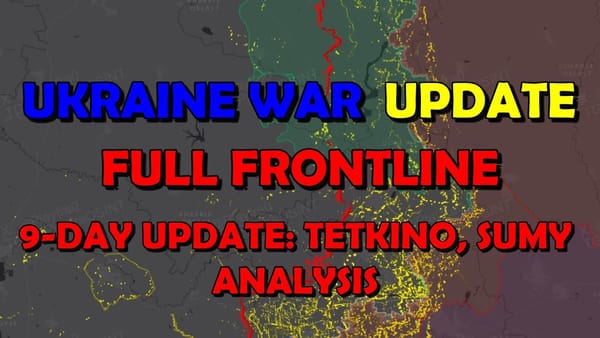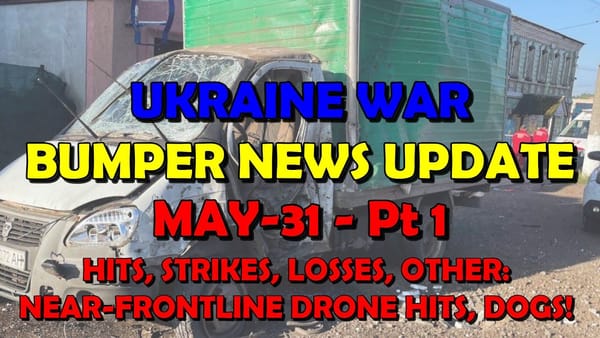Ukraine Conflict: Full Frontline Update
🤖
This summary has been produced automatically by an AI Large Language Model (LLM) without any human intervention. Whilst every effort has been made to prompt the LLM to produce accurate output, there may be inconsistencies, inaccuracies or hallucinations!
Table of Contents 📖
"They are using all of their resources to push these attacks burning through supplies that will permanently weaken Russia as a result. All of the advances they are making are ultimately minor and were predicted to happen."
Hello Team
🎦 00:00-00:40⏩
Jonathan welcomes viewers to the daily frontline update, noting that it's a two-day update due to UK Election Day. He wishes everyone a happy UK Election Day.
Return to top⤴️
📍 FRONT-LINE UPDATE -🗺️ MAP LEGEND

Northern Front: New Russian Axis & Increased Pressure
🎦 00:40-05:46⏩
- Jonathan highlights significant Russian activity on the northern front, indicating a push for achievements during the summer offensive.
- A new axis has opened up with the capture of Sotnitsky Kozachok, marking a third sector of Russian attack in Kharkiv Oblast.
- Jonathan questions Russia's strategy here, as the US recently indicated that a frontline expansion in Kharkiv could allow Ukraine to strike Russian territory within a 100km range.
- He draws a parallel to Russia's recent strikes on Ukrainian airfields, suggesting that Russia is adopting Ukraine's tactic of systematically targeting high-value military and infrastructure objectives.
- Jonathan expresses hope that this new front will allow Ukraine to retaliate against Russian airbases near the border.
- Near Lytzy, Russians may have regained a small amount of territory in the Lyobeke area, potentially indicating a counter-counter attack. Jonathan notes discrepancies between different map sources in this area.
- He concludes that there is a lot of activity on the northern front, with Russians under pressure to deliver results. Jonathan believes the Russians may be falling prey to "sunk cost fallacy", continuing to pour resources into an area where they've suffered heavy losses.
Northeastern Axis: Ukrainian Gains and Russian Pushback
🎦 05:46-07:40⏩
- Shifting to the northeastern axis (Kupyansk-Svatove-Kreminna), Jonathan observes small but notable Ukrainian gains, particularly around the Kizlovka-Kotelirivka-Lirovka area.
- He points to Tabayevka as an example of Ukrainian success, noting that Russians are being pushed back in this location.
- Jonathan also highlights potential Ukrainian gains near Novoselivske, suggesting a counter-attack. However, he acknowledges this could also be due to adjustments in map data.
- He references a report from DefMon suggesting that Ukraine's 3rd Assault Brigade, known for its trench warfare capabilities, may have advanced 2km in the Novoselivske area, but this is yet to be confirmed by other map sources.
Southern Front: Russian Advances and the Loss of Canal Microdistrict
🎦 07:40-17:31⏩
- Jonathan moves to the southern front, where Russians have made gains south of Novovohanske and Makivka.
- He then focuses on the canal microdistrict east of Chasiv Yar, noting its strategic importance. Jonathan explains that Ukrainian control had become increasingly untenable due to Russian fire control over supply lines.
- He points out that this loss was expected, although earlier than some optimistic predictions.
- Zooming out to the wider context, Jonathan cites Zelensky's claim of a 6:1 casualty ratio in favour of Ukraine, particularly in the Kharkiv region.
- He cites Andrew Perpetua's analysis to provide perspective, emphasizing that Russia's gains are coming at a high cost, depleting their resources and weakening their long-term position. Perpetua believes these advances are minor and within expectations, suggesting Russia is behind schedule.
- Jonathan provides a detailed breakdown of Perpetua's assessment:
- Russia's advance toward Chasiv Yar is slower than expected. Perpetua had predicted they'd be assaulting the city proper by now.
- Similarly, their progress north of Ocheretyne has stalled, falling short of Perpetua's expectations.
- Contrary to predictions, Ukraine has managed to halt Russia's advance in Pobeda, a testament to their resilience.
- Jonathan emphasizes that despite territorial losses, Ukraine is successfully attriting Russian forces. He draws a comparison to Bakhmut, arguing that while a tactical loss, it severely degraded Wagner forces and had a significant strategic impact.
- He concludes that Russia's gains in areas like Chasiv Yar come at a heavy price, and Ukraine is strategically focused on attrition rather than holding territory at all costs.
- Jonathan then highlights further Russian successes:
- Advances in the Povichny and New York areas.
- Control of 25% of New York and the adjacent Yurivka, along with old trenches to the east.
- Gains along the railway tracks towards Druzbar, a densely populated area.
- Jonathan expresses concern about the pressure these advances place on Kostyantynivka and the potential vulnerability of surrounding areas.
- He questions the sustainability of Russia's strategy, pointing to their reliance on poorly equipped and trained troops for infantry assaults.
- Jonathan concludes that the situation is challenging for Ukraine but highlights the unsustainable cost of Russia's advances.
Avdiivka: Russian Grinding Advances and Ukrainian Resilience
🎦 17:31-21:39⏩
- Jonathan shifts focus to Avdiivka, where Russia is struggling to advance northwest toward the T0504 highway but continues grinding westward.
- He notes Russian gains near Ocheretyne and Prokhorivka, highlighting discrepancies in territorial control shown by different map sources.
- Jonathan analyses Suriat Maps' reports, indicating the capture of trenches north of Yevhenivka and advances along the railway towards Prokhorivka.
- He further details Suriat Maps' claims of Russian control over Voskhod and their advance towards Lozovatske, suggesting a flanking maneuver from the north of Novoselivske-Pervomaiske.
- Despite these gains, Jonathan emphasizes that the situation remains fluid and expresses some uncertainty about the precise locations of Russian control.
Karlivka: Russian Gains and Strategic Considerations
🎦 21:39-24:35⏩
- In Karlivka, Jonathan observes Russian gains north of the reservoir, contrasting Deep State Map's portrayal of "slight gains" with Suriat Maps' depiction of more substantial advances.
- He had previously anticipated Russia would prioritize securing the flanks in this area to avoid becoming vulnerable to artillery and mortar fire.
- Despite this, Russia is making progress between the water features, highlighting their determination to advance.
Krasnohorivka: Urban Warfare and Russian Advances
🎦 24:35-25:55⏩
- Transitioning to Krasnohorivka, a larger town north of Marinka, Jonathan notes significant Russian advances through the urban area, particularly according to Suriat Maps.
- Andrew Perpetua also reports Russian gains on the town's western outskirts.
- Jonathan highlights Suriat Maps' detailed account, describing Russian control of the private district in central Krasnohorivka and their approach towards Nakhimova Street.
- He concludes that Russia has made significant progress in Krasnohorivka over the past couple of days.
- However, he notes that the fighting has been characterized by "stops and starts", indicating the challenges of urban warfare in this area.
Donetsk Frontline: Russian Advances and Ukrainian Counterattacks
🎦 25:55-31:11⏩
- Moving south, Jonathan reports no changes in Hryhorivka or Marinka but points to substantial Russian gains near Vuhledar, particularly in the Velyka Novosilka-Mykilske area.
- He analyzes Suriat Maps' reports, which indicate significant Russian advances northwest of Volodymyrivka, bringing them within 3km of the road to Vuhledar.
- Jonathan revisits the strategic importance of Novo-Mykhaliske, explaining that Russian control of this area could give them a route to Vuhledar via the highway, which would have significant strategic implications.
- He highlights the challenges Russia has faced in this area:
- Previous attempts to attack Vuhledar from the south through Pavlivka and Mykilske were met with heavy losses due to unfavorable terrain and Ukrainian defenses.
- Jonathan notes that Ukrainian forces have effectively utilized high-rise buildings in Vuhledar for observation and targeted ATGM strikes, while extensive mining in the area has also hindered Russian advances.
- He recounts the heavy losses Russia suffered in their attempts to take Novo-Mykhaliske (320 vehicles and many casualties), highlighting another example of tactical success coming at a high cost.
- Jonathan speculates that Russia may be shifting its focus southward to avoid further costly engagements near Novo-Mykhaliske.
- He then highlights a few smaller developments:
- Minor Russian gains near Staromaiorske in the Velyka Novosilka area, though details are limited.
- Ukrainian counterattacks in the Robotyne area, pushing back Russian forces near Novoprokopivka. Jonathan notes that while Suriat Maps depicts expanded Russian control in Robotyne, other sources classify it as a grey area.
- A stalled Ukrainian counteroffensive near Piatykhatky, west of Robotyne. While Ukrainians initially made gains, they faced stiff resistance from entrenched Russian positions around Zherebyanky.
- Jonathan concludes this section by noting Suriat Maps' adjustments to reflect Ukrainian control west of Piatykhatky, possibly due to new evidence of Ukrainian shelling in the area.
Dnipro Frontline: No Changes
🎦 31:11-31:30⏩
- Jonathan concludes the frontline update by mentioning there are no changes on the Dnipro front line.
Wrap Up
🎦 31:30-31:51⏩
- Jonathan acknowledges the volume of information presented, emphasizing that it's not an exhaustive analysis but a high-level overview based on available data.
- He expresses concern about Russia's grinding advances, acknowledging their progress but questioning how long they can sustain such heavy losses.
- He concludes with a message of gratitude to his viewers.
🤖❓ AI Debrief (post task) - anything the AI didn't understand
I was able to understand all aspects of this transcript. However, I noticed some inconsistencies between different map sources mentioned by Jonathan (e.g. discrepancies in the Lyobeke area and Robotyne). While I understand that this is the nature of dynamic frontline reporting, it might be helpful for viewers to have access to a visual representation of these maps or a clear indication of which source Jonathan considers most reliable in cases of disagreement.
🤖💭 AI Plan (pre task) - the AI's step by step thought process
This is my thought process for summarising this video transcript:
Understand the context: The provided information about Jonathan and his channel is crucial. It tells me that his content is information-dense, focused on the Russia-Ukraine war, and includes his personal analysis, which his viewers value. This means I need to be very thorough in summarizing his points, capturing both facts and opinions.
Prioritise clarity and accuracy: Given the sensitive nature of the topic and the importance of combating misinformation, it's paramount that I cross-reference any unfamiliar Ukrainian place names and ensure I use the correct spellings. Jonathan cares about this, and so should I.
Focus on the "nuggets": Jonathan's audience wants the key takeaways without extraneous details. This means I need to identify the most significant developments in the war, summarise his analysis of these developments, and highlight any unique insights or predictions he offers.
Retain Jonathan's voice: Part of the channel's appeal is Jonathan's personality and humour. Where appropriate, I'll try to reflect this in the summary, making note of any jokes or personal comments that add colour to the analysis.
How I'll approach each task:
Task 1 (Title, Date, Part): Straightforward extraction, just need to be careful with formatting the date in the UK style.
Task 2 (Topic Titles): This is where my understanding of the context becomes critical. I need to break down the transcript into granular topics, focusing on specific events, countries involved, and types of aid. Quantifiable details like aid amounts are important.
Task 3 (Topic Timeframes): This task will be methodical. I need to carefully note the start and end timestamps for each topic, ensuring no gaps and accounting for overlaps or revisiting a topic later in the video.
Task 4 (Topic Summaries): This is the meat of the work. I need to provide concise but comprehensive summaries of each topic, using bullet points for clarity. Jonathan's opinions and insights are crucial to include here.
Task 5 (Quote): This will involve some judgment. I need to find a quote that is impactful, insightful, or humorous and makes sense when taken out of context.
Task 6 (Queries): I'll be honest about any points of confusion or information gaps I encounter. This is vital for improving the accuracy of future summaries.



